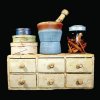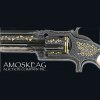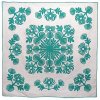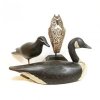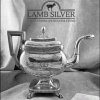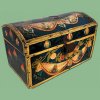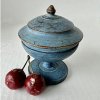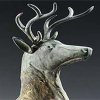Christie's Americana
September 20th, 2017
Christie’s, New York City
Photos courtesy Christie’s
The week the United Nations convened in New York City to discuss peace and security, climate change, humanitarian aid, human rights, and economic development was not the best time to hold an Americana sale. John Hays, Christie’s deputy chairman, apparantly did not realize that Donald Trump was going to be in New York City for the events at the U.N. during two days of the four-day preview and on the day of sale, September 20. Traffic was at a standstill. It wasn’t easy to get to Christie’s. Nevertheless, some collectors and dealers did preview, and 22 prospective bidders took seats in the salesroom. Most of the bidding was on the phones or on the Internet, which was a slow process. The sale of 184 lots (of which 169 sold) took three and a half hours! Those who like to watch sales live found that the live streaming did not work with some browsers, but the bids were recorded on a silent screen, and online bidding was possible. The sale brought $1,778,000 (toward the low end of total presale estimates of $1.3/2.1 million, figured without the 25% buyers’ premiums). The sale was 92% sold by lot.
There were some strong prices that went well over conservative estimates and some good buys. The Reynell-Coates family Queen Anne carved walnut compass-seat side chair with an incurved seat with a carved shell, a very desirable form from a well-known set of chairs, with an estimate of $50,000/80,000, sold for $137,500 (including buyer’s premium), despite the fact that its splat and crest had been professionally repaired. It is another treasure from the Martin Wunsch estate. It had failed to sell at Christie’s in January 2014 when it was estimated at $200,000/300,000. The buyer was New York City dealer Frank Levy of Bernard and S. Dean Levy, who was bidding on the Internet.
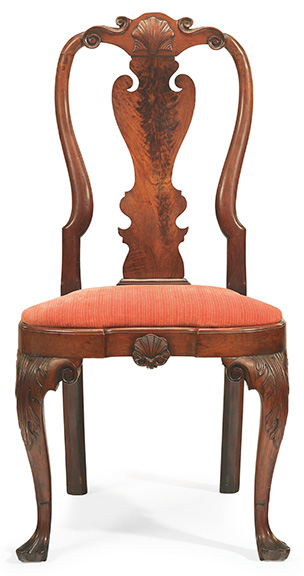
The Reynell-Coates family Queen Anne carved walnut incurvate compass-seat side chair with carving possibly by Samuel Harding (d. 1758) or Nicholas Bernard (d. 1789), Philadelphia, 1740-55, the slip seat marked XII, the frame marked II, 41½" high, with a Kindig and Sack provenance, sold for $137,500 (est. $50,000/80,000) to New York City dealer Frank Levy of Bernard and S. Dean Levy, bidding on the Internet. It was from a very desirable set of Philadelphia Queen Anne chairs. This has had some repairs, and a front leg was well done. The chair was from the estate of Martin Wunsch, which Christie’s has been offering over the last several years. Christie’s had offered the chair in January 2014 with a $200,000/300,000 estimate, and it failed to sell. Its design was among the most expensive in the 1750s. The carver made one volute smaller than the other, perhaps a carving mistake when it was made, not a restoration. This chair has a splat similar to splats on the so-called Reifsnyder chairs, which are a bit more elaborate, with egg-and-dart carving on their shoes. The Reifsnyder chair from the Wunsch collection sold at Christie’s in September 2013 for $579,750 (est. $200,000/300,000).
A 1750-60 Philadelphia walnut dressing table, attributed to the Clifton/Carteret shop, the carving attributed to Nicholas Bernard, sold for $106,250 (est. $30,000/50,000) on the phone to Delaware dealer James Kilvington for a client. In June 2005 it had sold at Skinner for $171,000. A dressing table at Winterthur has a similar skirt profile and knee returns with scroll embellishments and similar trifid feet.
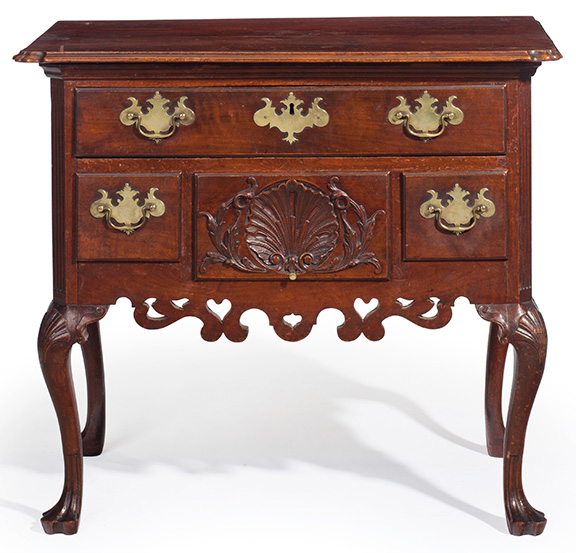
Queen Anne carved walnut dressing table, case attributed to the shop of Henry Clifton and Thomas Carteret, carving attributed to Nicholas Bernard, Philadelphia, 1750-60, sold for $106,250 (est. $30,000/50,000) on the phone to dealer James Kilvington bidding for a collector. At Skinner in 2005, it had sold for $171,000 (est. $15,000/25,000). According to the catalog, the attribution to the Clifton-Carteret shop is based on similarities to a signed dressing table and high chest at Winterthur, including the presence of vertical drawer dividers, dust boards secured by long glue blocks, the skirt profile with pierced ornament, and similarly carved legs and feet.
There were some real bargains. A Chippendale carved mahogany scallop-top tea table with a repair to one leg, estimated at $8000/12,000, sold for $7500. Other piecrust tea tables from the same shop with larger tops have sold for a lot more. One with a 31½" diameter top sold for $146,500 (est. $60,000/150,000) to C.L. Prickett in 2011 at Sotheby’s. Christie’s had sold that table for $145,500 (est. $100,000/150,000) in January 1996.
Two lots of two chairs each sold for $80,000 total to a collector on the phone, underbid by the trade. They were attributed to the shop of Thomas Tufft. Each pair was estimated at $30,000/50,000. The four chairs had sold for $105,000 at Northeast Auctions, Portsmouth, New Hampshire, in August 2015. At this sale the first pair was hammered down at $32,000. The bidder had the option to buy the second pair at the same price or to compete for them, and he exercised his option to buy. After the sale he said he wondered if taking that option was the right choice, but he wanted all four of them.
Other pieces of American furniture that hammered for over their estimates included a Massachusetts serpentine-front chest of drawers with a conservative $12,000/18,000 estimate. It sold for $35,000. A Federal mahogany and figured maple veneer Boston worktable, 1805-15, estimated at $6000/9000, sold for $26,250.
Federal furniture generally performed poorly. One pair of Massachusetts Federal card tables with shell inlays was passed, and other Federal card tables sold for only $375 (est. $3000/5000), $625 (est. $5000/8000), and $1375 (est. $3000/5000). Two similar New England inlaid cherrywood card tables sold for $1750 (est. $2000/3000). A figured maple and flame birch inlaid mahogany North Shore, Massachusetts, or New Hampshire card table that sold for $1500 (est. $1000/2000) had sold at Sotheby’s in 2000 for $14,400 (est. $4000/6000) and earlier at Sotheby’s on October 10, 1998, for $8625.
On the other hand, a fine pair of brass and wrought-iron andirons, made in New York, 1800-20, along with two tongs and two shovels, sold for $11,875 (est. $1500/2000) to the trade, showing that quality is not overlooked.
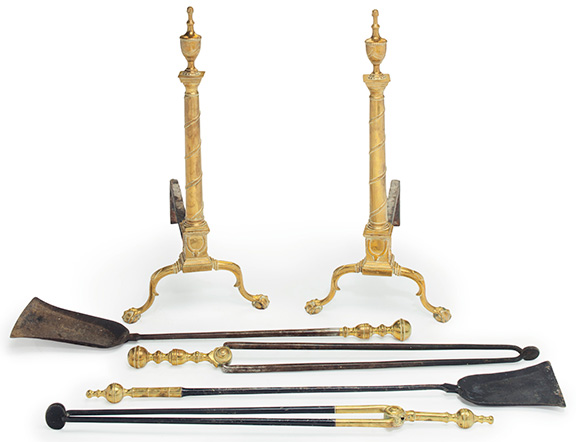
This pair of Federal brass and wrought-iron andirons, New York, 1800-20, together with two pairs of tongs and two shovels, the andirons 28½" high, sold on the phone for $11,875 (est. $1500/2500).
Two pieces of Aesthetic Movement furniture from the collection of the late Richard Schwartz sold within estimates. William H. Vanderbilt’s rosewood inlaid maple console table, attributed to Herter Brothers, had been in the 1994-95 Herter Brothers exhibition that was at the Metropolitan Museum of Art in 1995. It sold for $52,500 (est. $40,000/60,000). Katherine S. Howe, one of the authors of the Herter exhibition catalog, wrote that it has “one of the most delicate carved heads ever to appear on a piece of Herter furniture.” The carved vases on its bottom shelf are also exquisite. It seemed to be a bargain. A massive parcel-gilt and ebonized sideboard, with onyx mounts and an over mirror, supported by carved elephant-head feet, was also attributed to Herter Brothers. It sold for $56,250 (est. $25,000/50,000). The sideboard’s size kept its price down.
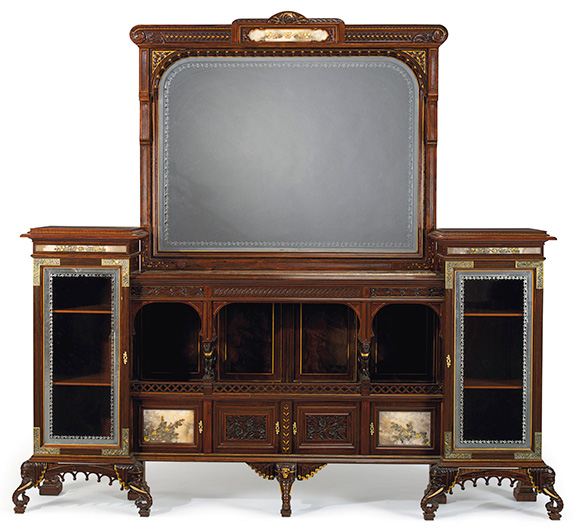
This Aesthetic Movement parcel-gilt, part-ebonized, silver-, ormolu-, and onyx-mounted rosewood sideboard and over mirror, attributed to Herter Brothers (active 1864-1906), New York, circa 1881, bears stencils reading “65147 SINCLAIR,” and some locks are stamped “G. Bayer / N.Y. Patd. June 14, 1881.” The 99" high x 101" wide x 24" deep sideboard has feet in the form of elephant heads with the trunks lifting a weight. It sold for $56,250 (est. $25,000/50,000).
Among other successes in the sale was a huge polychrome sternboard eagle that sold on the phone to the trade for $62,500 (est. $5000/10,000). A painting of the bombardment of Fort Fisher, an 1888 oil on canvas rendering of the last Confederate fort to fall to Union troops in the Civil War in 1865, by Thomas Laycock (1840-1898) sold for $75,000 (est. $7000/10,000). Laycock’s drawing of the bombardment became the basis of a widely circulated lithograph published by Endicott & Co., New York, in 1865.
A carved pine ship figurehead of a young woman, attributed to Philadelphia carver William Rush (1756-1833), circa 1809, 46½" high, missing the arms, retained traces of red and white paint. It sold on the phone for $52,500 (est. $30,000/50,000). At Sotheby’s in October 2000, it had sold for $137,750 to Jack Warner, and it became part of the Westervelt collection, named for a paper corporation in Tuscaloosa, Alabama. Bill Samaha was the underbidder in 2000. Quakertown, Pennsylvania, advisor and conservator Alan Miller, the underbidder in 2017, said the nose was replaced, but he thought the figure was probably early Rush, and he had figured out what the arms must have looked like. John Hays said he had the wood tested, and it was American pine. The drapery and eyes relate to illustrations of sculpture by Rush in the 1982 catalog and exhibition William Rush: American Sculptor, an exhibition at the Pennsylvania Academy of the Fine Arts that celebrated America’s first native-born sculptor.

This carved pine ship figurehead, attributed to William Rush (1756-1833), Philadelphia, circa 1809, 46½" high x 15" wide x 17½" deep, retains traces of red and white paint and sold for $52,500 (est. $30,000/50,000). At Sotheby’s in October 2000, it sold for $137,750 (est. $40,000/60,000) to Jack Warner, and it was part of the Westervelt collection in Tuscaloosa, Alabama. A replaced nose made some question the attribution, but the consensus by sale time was that it was probably an early Rush. The wood is American pine. It sold to a phone bidder, underbid by Alan Miller, who said he figured out what the arms must have looked like.
A few pieces of Outsider art helped swell the sale total. A Bill Traylor artwork with four figures, Two Women in Orange, Two Men in Blue, on repurposed cardboard, sold for $75,000 (est. $50,000/80,000). A large James Castle untitled construction of found paper, string, thread, soot, and spit sold for $43,750 (est. $40,000/60,000). A yarn, gauze, and fabric abstract sculpture, 50½" high, by Judith Scott, a California artist who had Down syndrome and is known for her wrapped sculptures, sold for $32,500 (est. $12,000/18,000).

Untitled (1993-14) by Judith Scott (1943-2005), 1993, yarn, gauze, and fabric over found card and plastic objects, 50½" high x 7" wide x 7" deep, sold for $32,500 (est. $12,000/18,000). Fiber artist Judith Scott is renowned for her intricately wrapped sculptures that transform everyday found objects into cocoon-like, abstract forms. Born with Down syndrome, the artist lost her hearing early in life, and art became her main method of communication. She worked at the Creative Growth Art Center, Oakland, California, from 1987 until her death in 2005.
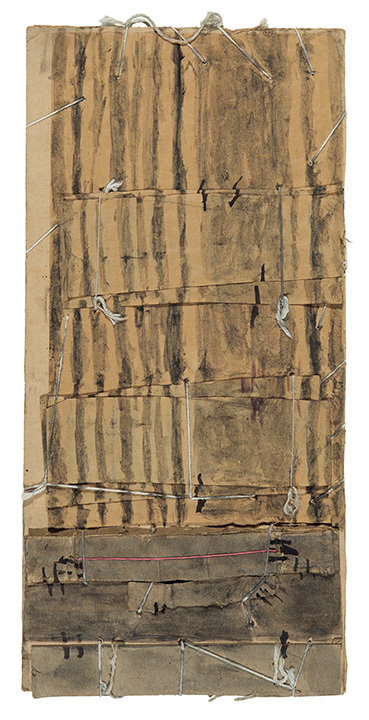
James Castle (1899-1977), untitled construction, found paper and card, string, thread, soot, and spit, 17¾" x 8½", Knoedler & Company provenance, sold for $43,750 (est. $40,000/60,000). An entire wall in the permanent collection gallery at the Whitney Museum of American Art in New York is devoted to the work of James Castle, who shares the same gallery with Edward Hopper, Charles Sheeler, and Charles Demuth.
A silver punch bowl with 24 matching cups made by Reed & Barton in the 20th century sold for $35,000 (est. $15,000/25,000), and a Tiffany mixed-metal large water pitcher with two matching beakers, circa 1878, sold for $37,500 (est. $30,000/50,000).
 John Hays said it was hard to get major consignments for the fall sale, but he believes Christie’s needs two Americana sales a year, one in September and another in January, in order to settle estates, and, more important, to keep Americana on people’s radar. He finds collectors unwilling to sell in a market that is not buoyant, but he said he has some surprises for January, including a discovery of a long-lost set of Philadelphia Rococo chairs that turned up in Canada.
John Hays said it was hard to get major consignments for the fall sale, but he believes Christie’s needs two Americana sales a year, one in September and another in January, in order to settle estates, and, more important, to keep Americana on people’s radar. He finds collectors unwilling to sell in a market that is not buoyant, but he said he has some surprises for January, including a discovery of a long-lost set of Philadelphia Rococo chairs that turned up in Canada.
The pictures and captions tell more; the entire priced catalog can be viewed online at (www.christies.com). In order to watch Christie’s sales live, an online account must be created, but live streaming does not work with all browsers. Christie’s is working on making its website more user-friendly.
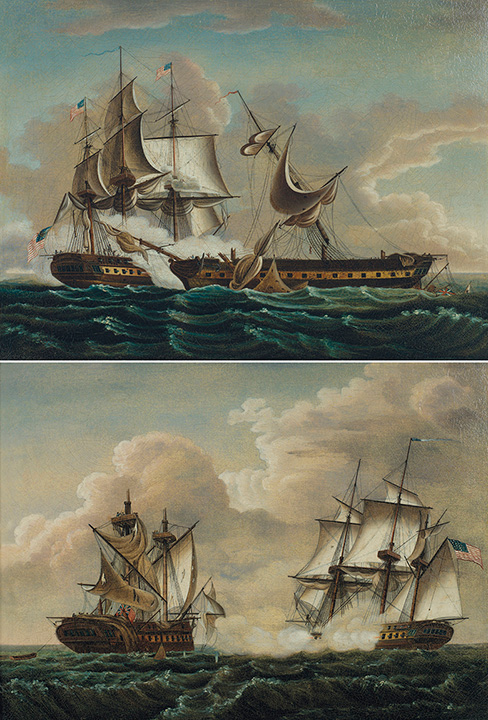
Attributed to Michele Felice Cornè (1752-1845), a pair of oil on canvas naval battle scenes showing the U.S.S. United States vs. H.M.S. Macedonian and U.S.S. Constitution vs.H.M.S. Guerriere, 18" x 23¾ " each, sold for $25,000 (est. $8000/12,000). They had last sold at Sotheby’s in 1993 for $16,675 (est. $7000/10,000).
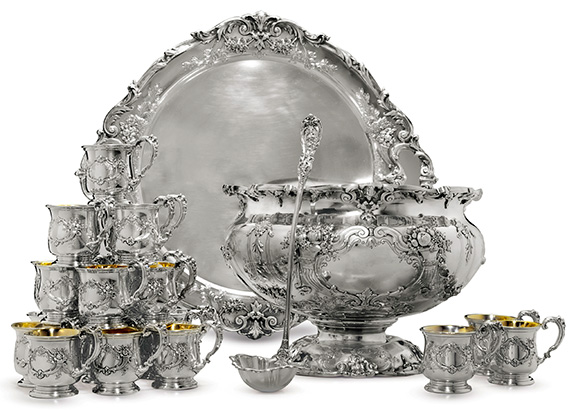
This impressive mid-20th-century silver punch bowl with a tray and 24 matching cups is marked for Reed & Barton, Taunton, Massachusetts, and is in the Francis I pattern. All the pieces are of circular form and are chased with fruit and flower-filled cornucopias linked by garlands. The bowl and cups have gilt interiors. The set includes a matching punch ladle with a shaped oval bowl. Marked on the undersides, the bowl and cups are numbered “RS321” and the tray is numbered “RS322.” The tray is 24¾" long over handles; the punch bowl is 15¼" diameter; and the set weighs 491 oz., 8 dwt. It sold for $35,000 (est. $15,000/25,000).

This burlwood oval bowl, 7¾" high x 24" diameter, sold for $16,250 (est. $1000/1500). Jack Warner purchased it at Marshall Field & Co. in Chicago, according to the catalog.
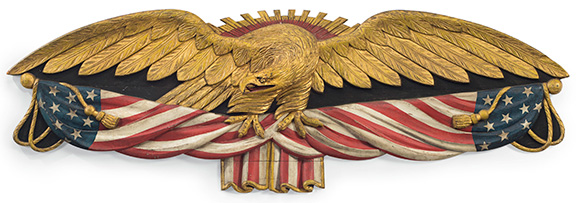
Polychrome paint-decorated and carved giltwood spread-wing eagle plaque, late 19th/early 20th century, 27" high x 82½" wide, sold on the phone for $62,500 (est. $5000/10,000). Bill Stahl said it had belonged to Mrs. Norman Woolworth and that it had sold at Sotheby’s in the late 1990s for about the same price.
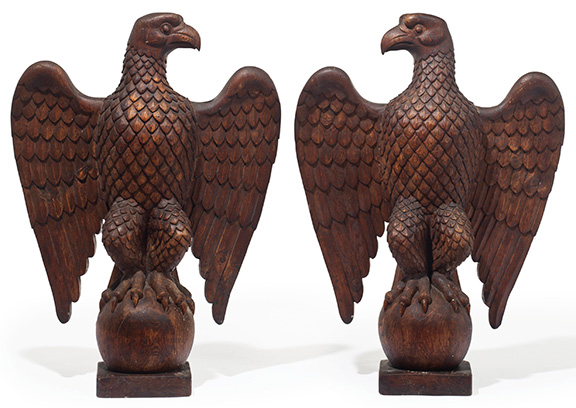
This pair of carved pine spread-wing eagles, 19th century, each 40" high x 29" wide, sold for $3125 (est. $10,000/20,000). The pair had sold at Northeast Auctions in August 2001 for $18,400 (est. $8000/10,000). They had been part of the Westervelt collection.
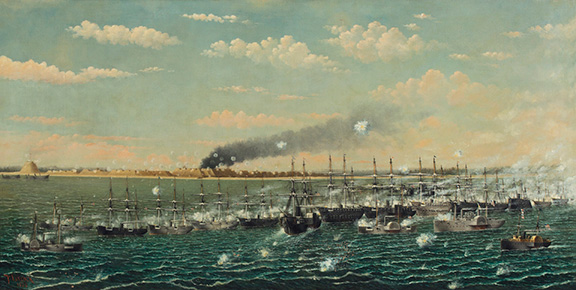
Retired U.S. Navy Master Thomas F. Laycock (1840-1898) painted this large oil on canvas of the Bombardment of Fort Fisher, 1888, long after he made the drawing that became the basis for the widely circulated and well-known lithograph of the same scene published by Endicott & Co. in 1865. This 36¼" x 72" painting is signed and dated “T. Laycock 1888” lower left. It sold for $75,000 (est. $7000/10,000). Fort Fisher, outside Wilmington, North Carolina, was the last Confederate fort to fall to Union troops in the Civil War. This Confederate loss, which isolated the South from trade routes, solidified the path to Union victory.
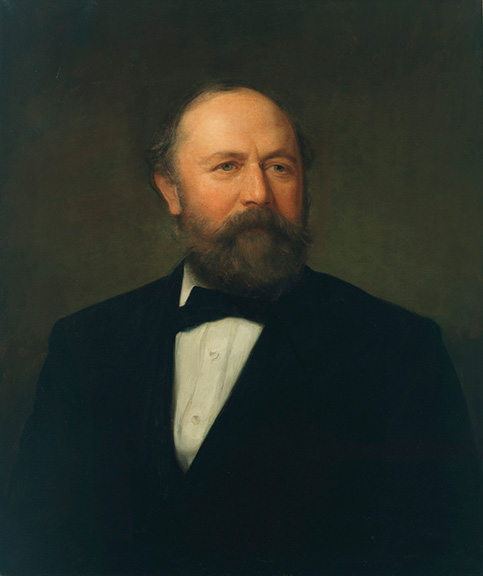
Eastman Johnson (1824-1906) did this portrait of President James Garfield. The reverse is hand inscribed in ink “JAMES GARFIELD / PRES. U.S.A. / 1831-1882 / E. Johnson 1881” and “Eastman Johnson / N.Y. 1884.” This 30" x 25 1/8" oil on canvas sold for $10,000 (est. $6000/9000). It is one of four presidential portraits offered at the sale. Not shown, a small 17" x 13¾" portrait of Andrew Jackson, attributed to Nathan Wheeler (1789-1849), sold for $9375 (est. $5000/10,000). Portraits of George Washington always bring a premium. One 30" x 25" 19th-century oil on canvas, not attributed to a particular artist, sold for $20,000 (est. $5000/10,000), and another, 27¼" x 22", sold for $3250 (est. $4000/6000).
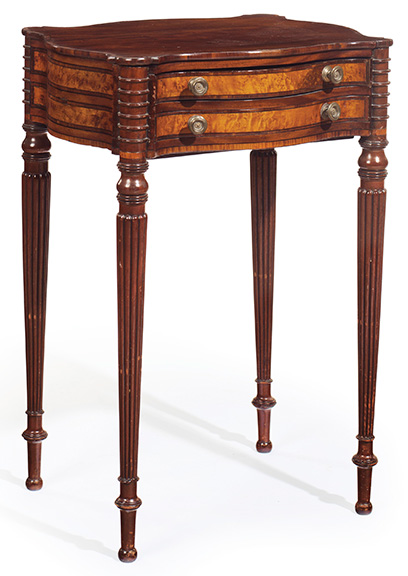
Two bidders wanted this Federal mahogany and figured maple veneered Boston worktable, 1805-15, 27½" high x 19½" wide x 16" deep. It sold for $26,250 (est. $6000/9000). Its pronounced shaping, finely executed turned and veneered details, and meticulous construction all indicate it was produced in Boston, where affluent residents supported highly skilled cabinetmaking, as pointed out by Diane Carlberg Ehrenpreis in Brock Jobe’s Portsmouth Furniture: Masterworks from the New Hampshire Seacoast (1993), where this piece is illustrated (p. 272, fig. 67A).
Originally published in the November 2017 issue of Maine Antique Digest. © 2017 Maine Antique Digest




